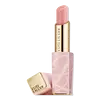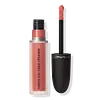What's inside
What's inside
 Key Ingredients
Key Ingredients

 Benefits
Benefits

 Concerns
Concerns

 Ingredients Side-by-side
Ingredients Side-by-side

Ricinus Communis Seed Oil
MaskingGlyceryl Triacetyl Ricinoleate
EmollientCetyl Ricinoleate
EmollientEuphorbia Cerifera Wax
Bis-Diglyceryl Polyacyladipate-2
EmollientCopernicia Cerifera Wax
Polyethylene
AbrasiveEthylhexyl Palmitate
EmollientTriticum Vulgare Bran Extract
Skin ConditioningOlea Europaea Fruit Extract
BleachingPalmitoyl Tripeptide-1
Skin ConditioningButylene Glycol
HumectantCholesterol
EmollientGlyceryl Stearate
EmollientTribehenin
EmollientLauryl Methacrylate/Glycol Dimethacrylate Crosspolymer
Sodium Hyaluronate
HumectantPotassium Sulfate
Oleic Acid
EmollientSilica Dimethyl Silylate
EmollientPalmitic Acid
EmollientTocopheryl Acetate
AntioxidantVanillin
MaskingPentaerythrityl Tetra-Di-T-Butyl Hydroxyhydrocinnamate
AntioxidantSorbitan Isostearate
EmulsifyingAroma
Mica
Cosmetic ColorantCI 77891
Cosmetic ColorantCI 45380
Cosmetic ColorantCI 17200
Cosmetic ColorantCI 75470
Cosmetic ColorantRicinus Communis Seed Oil, Glyceryl Triacetyl Ricinoleate, Cetyl Ricinoleate, Euphorbia Cerifera Wax, Bis-Diglyceryl Polyacyladipate-2, Copernicia Cerifera Wax, Polyethylene, Ethylhexyl Palmitate, Triticum Vulgare Bran Extract, Olea Europaea Fruit Extract, Palmitoyl Tripeptide-1, Butylene Glycol, Cholesterol, Glyceryl Stearate, Tribehenin, Lauryl Methacrylate/Glycol Dimethacrylate Crosspolymer, Sodium Hyaluronate, Potassium Sulfate, Oleic Acid, Silica Dimethyl Silylate, Palmitic Acid, Tocopheryl Acetate, Vanillin, Pentaerythrityl Tetra-Di-T-Butyl Hydroxyhydrocinnamate, Sorbitan Isostearate, Aroma, Mica, CI 77891, CI 45380, CI 17200, CI 75470
Dimethicone
EmollientDimethicone Crosspolymer
Emulsion StabilisingIsononyl Isononanoate
EmollientPolyglyceryl-2 Triisostearate
EmulsifyingDiisostearyl Malate
EmollientTribehenin
EmollientTocopheryl Acetate
AntioxidantLecithin
EmollientEthylhexyl Palmitate
EmollientIsopropyl Myristate
EmollientPolyglyceryl-3 Polyricinoleate
EmulsifyingPolyglyceryl-2 Diisostearate
EmulsifyingSorbitan Isostearate
EmulsifyingDehydroacetic Acid
PreservativeIsostearic Acid
CleansingPolyhydroxystearic Acid
EmulsifyingVanillin
MaskingMica
Cosmetic ColorantCI 77891
Cosmetic ColorantCI 77491
Cosmetic ColorantCI 77492
Cosmetic ColorantCI 77499
Cosmetic ColorantCI 42090
Cosmetic ColorantCI 15850
Cosmetic ColorantCI 45380
Cosmetic ColorantCI 45410
Cosmetic ColorantCI 17200
Cosmetic ColorantCI 19140
Cosmetic ColorantCI 15985
Cosmetic ColorantDimethicone, Dimethicone Crosspolymer, Isononyl Isononanoate, Polyglyceryl-2 Triisostearate, Diisostearyl Malate, Tribehenin, Tocopheryl Acetate, Lecithin, Ethylhexyl Palmitate, Isopropyl Myristate, Polyglyceryl-3 Polyricinoleate, Polyglyceryl-2 Diisostearate, Sorbitan Isostearate, Dehydroacetic Acid, Isostearic Acid, Polyhydroxystearic Acid, Vanillin, Mica, CI 77891, CI 77491, CI 77492, CI 77499, CI 42090, CI 15850, CI 45380, CI 45410, CI 17200, CI 19140, CI 15985
Ingredients Explained
These ingredients are found in both products.
Ingredients higher up in an ingredient list are typically present in a larger amount.
Ci 17200 is a synthetic reddish-purple dye.
Ci 45380 is a synthetic dye that comes from coal or tar sources. Due to this, it is often used in small quantities.
A common name for this dye is Red 22. Red 22 imparts a warm reddish color.
Similar to Red 27, this dye changes color based on pH and moisture levels.
This dye is colorless when dry but turns pink between pH levels 0.0 to ~3.0.
Learn more about CI 45380Ci 77891 is a white pigment from Titanium dioxide. It is naturally found in minerals such as rutile and ilmenite.
It's main function is to add a white color to cosmetics. It can also be mixed with other colors to create different shades.
Ci 77891 is commonly found in sunscreens due to its ability to block UV rays.
Learn more about CI 77891Ethylhexyl Palmitate, also known as octyl palmitate, is created from 2-ethylhexyl alcohol and palmitic acid. It is a fatty acid ester.
The fatty acid content of Ethylhexyl Palmitate makes it an emollient. Emollients help soften and hydrate your skin by trapping moisture within.
Ethylhexyl Palmitate is also used to help improve the texture of cosmetics. It helps other ingredient dissolve in products and help disperse ingredients more evenly.
You'll likely find this ingredient in sunscreen, as it is often used to mix UV-blocking ingredients such as avobenzone and ethylhexyl triazone.
It can also help stabilize the fragrances in a product as a fragrance fixative.
Ethylhexyl Palmitate can be used to substitute mineral oil.
Due to its high fatty acid content, it may not be fungal-acne safe.
Learn more about Ethylhexyl PalmitateMica is a naturally occurring mineral used to add shimmer and color in cosmetics. It can also help improve the texture of a product or give it an opaque, white/silver color.
Serecite is the name for very fine but ragged grains of mica.
This ingredient is often coated with metal oxides like titanium dioxide. Trace amounts of heavy metals may be found in mica, but these metals are not harmful in our personal products.
Mica has been used since prehistoric times throughout the world. Ancient Egyptian, Indian, Greek, Roman, Aztec, and Chinese civilizations have used mica.
Learn more about MicaSorbitan Isostearate is an emulsifer and cleaning agent. It is created from isostearic acid and sorbitol.
As an emulsifier, Sorbitan Isostearate prevents oils and water from separating.
Due to its isostearic acid base, it may not be safe for Malassezia or fungal acne.
Learn more about Sorbitan IsostearateTocopheryl Acetate is AKA Vitamin E. It is an antioxidant and protects your skin from free radicals. Free radicals damage the skin by breaking down collagen.
One study found using Tocopheryl Acetate with Vitamin C decreased the number of sunburned cells.
Tocopheryl Acetate is commonly found in both skincare and dietary supplements.
Learn more about Tocopheryl AcetateTribehenin comes from glycerin and behenic acid.
It is used as an emollient, or moisturizer. Emollients form a thin barrier on skin to prevent moisture from escaping.
This ingredient may not be Malassezia folliculitis, or fungal-acne safe.
Learn more about TribeheninVanillin is the main compound of the vanilla bean. It is naturally occuring but can also be artificially created.
This ingredient exhibits antioxidant properties but is also a known skin-irritant.
Vanillism is the term of contact-dermatitis associated with the vanilla plant. The sap of the vanilla plant triggers skin irritation, swelling, and redness.
Learn more about Vanillin